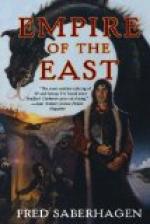“dz” is sounded like the “j” in “James.”
“nj” is sounded like the “gn” in French “campagne”: Tzetigne (Cetinje), and so on.
We are fully aware of many shortcomings, and for these we crave pardon, but if we benefit little Montenegro by the publication of our work, then we shall not have written it in vain.
England has once before proved the friend of Montenegro; the fighting instincts of that brave race, their love of freedom, and the possession of their most glorious of histories appeal to all of us.
I fear there are troublous times ahead for that gallant little nation, perhaps another bitter disappointment is in store for them, when they will need a friend.
Times have changed now, personal valour avails but little against overwhelming armies and modern artillery.
“We little nations must beseech the Almighty to give us peace,” said Prince Nicolas to me not so very long ago.
May it be His will!
R.W.
Vienna, February, 1903
THE LAND OF THE BLACK MOUNTAIN
CHAPTER I
Montenegro’s geographical position—Character of the people—Their honesty, patriotism, and love of arms—Likeness to the Homeric Greeks—The women—Montenegrin manners, vices, heroism, lack of privacy, police—Goodness of the Prince—The national costume—Religion—Hatred of Austria—Russia’s friendship.
Roughly Montenegro is diamond-shaped, with its points towards north and south, east and west. To the north-east it is bounded by the Sandjak of Novipazar, held by Turkey and Austria jointly, and dividing it from its parent country, the kingdom of Servia. To the south-east lies Albania, while Austria again borders Montenegro in Bosnia and the Hercegovina in the north-west and in Dalmatia to the south-west. Dalmatia and a narrow strip of the Adria complete the circuit, so Austria practically surrounds Montenegro on three sides.
The land may be said to possess three distinct belts of vegetation, each of an entirely different character. It is divided from north to south by the River Zeta, and the low-lying plains are fertile and rich, and this district also comprises the sea coast. To the west is the Katunska or “Shepherds’ huts,” those barren and rocky mountains of old Montenegro, from which the country derives its name; while to the east lies the Brda, mountains vying with Switzerland in beauty, rich grazing grounds and densely-wooded hills abounding with game, and the streams well stocked with fish.
The plains are the granaries of Montenegro, unfortunately too limited in area to give an abundance, but there is a mine of wealth in the Brda, when that part shall be opened up by connecting roads. The vast primeval forests and mineral products will be an important source of income in the times to come. Even at the present day the district constitutes the chief source of revenue from the export of cattle, sheep, and horses which flourish on the magnificent mountain pasturages. Montenegrin wool, greatly famed, comes too from the Brda.




